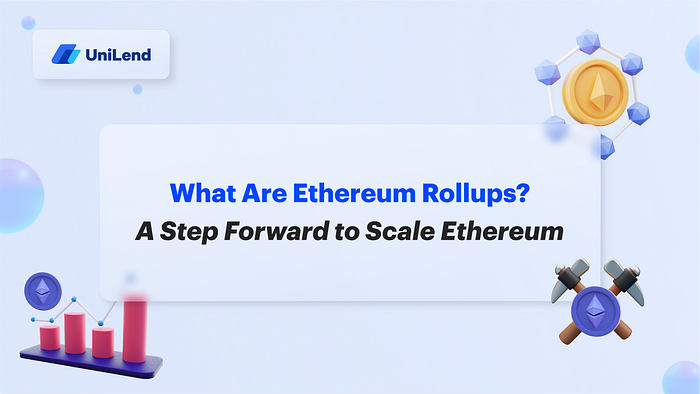What Are Ethereum Rollups? A Step Forward to Scale Ethereum

Even after the recent Ethereum updates and market downtrends, Ethereum remains expensive for many to use. The reason behind this is that the Ethereum blockchain has maxed out its capacity. Having to spend a few dollars or more in gas fees for a single transaction is not ideal.
That is why layer 2 systems such as rollups have emerged. They are designed to enhance the scalability of blockchain networks by enabling more transactions to be processed off-chain, while still maintaining the security and integrity of the network. These scaling solutions process transactions separately from the main network to help increase speed and lower costs.
In a rollup scaling solution, transactions are processed off-chain and then bundled together into a single transaction that is submitted to the main blockchain network. This significantly increases transaction throughput while reducing the computational burden on the main blockchain network.
Rollups are one of several scaling systems, which are methods to make a slow blockchain faster while lowering costs. Other scaling solutions include sidechains and state channels.
There are two main types of rollup scaling solutions for blockchain networks: Optimistic and Zero-Knowledge (ZK-rollups). The basic idea is to record dozens of transactions on the Layer 2 chain, then “roll up” into a single transaction which is then fed to ethereum instead of processing every single transaction on the main network. Doing this enables splitting the cost of a single transaction across many users.

Optimistic Rollups
The first type is called an Optimistic rollup. Optimistic rollups are a type of layer 2 scaling solution that relies on fraud proofs to ensure the validity of off-chain transactions. In other words, it is optimistically assumed that all the transactions contained within a rollup are valid. In an optimistic rollup, transactions are processed off-chain by a group of validators, who then bundle these transactions together and submit them to the main blockchain network.
In an optimistic rollup, each off-chain transaction is assumed to be valid by default. Optimistic rollup gives a certain amount of time, usually a week or two, to contest fraudulent transactions. If a fraudulent transaction is detected, anyone can submit fraud proof to the main blockchain network to challenge the validity of the transaction. The fraud-proof will include evidence that the transaction is invalid, and if the challenge is successful, the transaction will be rolled back. One drawback is that it usually takes about a week to officially withdraw your funds from popular networks like Optimism and Arbitrum.
Optimistic rollups have the advantage of being less complex and more flexible than zk-rollups. However, they are also more vulnerable to fraud and require more computational resources to process the fraud proofs.
zk-Rollups
The second type of rollup is Zero-Knowledge rollup, also called zk-rollup. zk-Rollups are a type of layer 2 scaling solution that uses a complex piece of cryptography called a zero-knowledge proof to ensure the validity of off-chain transactions. In a zk-rollup, transactions are processed off-chain and then bundled together into a single transaction that is submitted to the main blockchain network.
In a zk-rollup, each off-chain transaction is validated using a zero-knowledge proof, which proves that the transaction is valid without revealing any sensitive information about the transaction. This allows for a significant increase in transaction throughput, while also maintaining the privacy and security of the network. Compared to Optimistic rollups, zk-rollups allow withdrawals of funds to the main network with less delay.
zk-rollups have a number of advantages in terms of security and speed than optimistic rollups, but they are also more complex and require more advanced cryptographic techniques. So far, zk-rollups have had specific applications. Products such as Loopring and Immutable X leverage zk-rollups but are limited to one use case.
The Polygon team is close to launching the first zkEVM, zk-rollups that are functionally identical to Ethereum. Their zkEVM would be able to support virtually any application developers want to build on Ethereum, making things faster and cheaper for the users.
The Future of Rollups
Both types of rollups are still in their infancy and we are yet to see many advances. The networks on which they operate are somewhat centralized. Optimism has begun transitioning to community governance last year by launching Optimism Collective. Further advances in rollup technology should help tackle the centralization issue.
Overall, rollup scaling solutions are becoming an increasingly popular way to improve the performance and scalability of blockchain networks, while also reducing transaction fees and improving user experience. The choice between optimistic rollups and zk-rollups will depend on the specific requirements of the blockchain network and the trade-offs between security, efficiency, and complexity.
Website | Telegram Community | Announcements Channel | Twitter | Blog | Github | Reddit | Instagram
